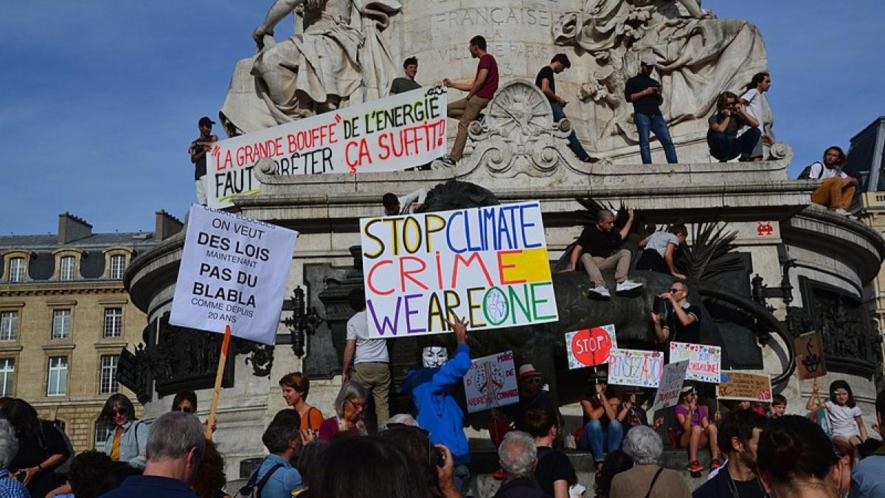Global Stocktake Report Reveals Urgent Climate Action Needs at COP28

Climate change protesters march in Paris. Representational Image. Image Courtesy: Wikimedia commons
The Paris Agreement (PA) had mandated a periodic five-yearly cycle of assessments of climate action called the Global Stocktake (GST) starting in 2023. GST is a process involving both country Parties i.e. governments, as well as non-party stakeholders to review progress made on the different actions agreed upon in the international negotiations under the aegis of the UN Framework Convention on Climate Change (UNFCCC) to tackle the greatest crisis to confront humankind, namely climate change. GST is expected to go beyond a retrospective review to chart out pathways to achieve the goals set by the Paris Agreement and, implicitly, raise ambitions towards ensuring these goals. The current cycle, underway for about two years now, will culminate in December 2023 at COP28 in Dubai where governments would examine the results of the GST and, hopefully, take appropriate decisions binding on all countries.
The GST consists of several processes such as data collection and analysis, technical assessment and political decision-making at the COP. The data collection process started in end-2021 during COP26 in Glasgow, then proceeded in parallel with the technical assessment which began in mid-2022, with both concluding in mid-2023 at the inter-sessional meeting in Bonn. Currently, the findings are being studied in what is termed the Consideration of Outputs phase which would culminate at COP28. The assessment process has been taking place through three Technical Dialogues (TD 1, 2 and 3) at the inter-sessional meetings in mid-mid-2022 and 2023 along with the intervening COP27 in the end-2022. A final Synthesis Report was released towards the end of September 2023 and will be the main input into follow-up decision-making at the forthcoming COP28.
This Report is, or should be, a watershed moment in the international climate negotiations, certainly in the post-PA phase. However, it barely received any attention in the media worldwide. Perhaps it got crowded out by the wall-to-wall coverage of the war in Ukraine in the Western media. Maybe the perception was that the real action is to take place in December at COP28, when there will be a media circus anyway, so why not wait? Or perhaps climate fatigue has set in, at least as regards news about steps to curb emissions, since nothing special seems to be happening on that front. The increasingly frequent and more severe forest fires, heat waves, floods, polar and glacial ice-melts, and droughts in different parts of the world should be drawing attention as much to what needs to be done to check them as to the disasters themselves.
Preliminary stocktake findings
The tragedy is that, indeed, international efforts to cut down emissions of greenhouse gases (GHG), especially carbon dioxide, mostly from the burning of fossil fuels, are progressing extremely slowly and lack the required urgency, even while climate impacts are worsening, that too far more quickly than earlier projected.
The Synthesis Report of the Technical Dialogue of the First Global Stocktake (GST-TD Syn) says just that. But this is not news. Every recent Report from every scientific agency has said the same thing and has been repeating it over many years before that too. The Synthesis Report of the Sixth Assessment Report of the Intergovernmental Panel on Climate Change (IPCC/AR6) which puts together and summarizes the three volumes of the IPCC report covered this ground thoroughly, with detailed estimates of how far short the world is from where it ought to be in order to restrict global average temperature rise to 2 degrees C or as close to 1.5C as possible. So did the Emissions Gap Report, and so on.
It is no surprise then that GST-TD Syn too sums up the current status in similar, stark terms. However, it downplays it somewhat by also emphasizing the improvements achieved, even if these are much less than required, albeit better than before. The Report notes this pattern of mixed results by individual countries, especially developed nations, as well as when put together on a global level, in all the major parameters being monitored under the Global Stocktake viz. mitigation or reduction of GHGs, adaptation, and resilience to climate impacts, and implementation mechanisms such as assistance to developing countries in finance, technology, capacity-building, and the recently added loss and damage. So, the picture the Report paints is one of a glass quarter full but, seen another way, a glass three-quarters empty.
The intention clearly is to show that the international negotiations are indeed showing progress, and some positive results on all fronts so that despondency or frustration do not set in. On the other hand, such a portrayal has the danger of lulling governments, other non-state players, and the general public into believing that everything is going in the right direction, that there is nothing to worry about, and emissions will gradually come under control to the required level, stopping or reversing climate change.
The hard truth is that, whatever gains have been made, are woefully short of requirement and that emissions remain at dangerous levels, global temperature rise appears set to go above the 2C leave alone 1.5C mark, with impacts already being witnessed and threatening to get much worse.
The question therefore is: will COP28 look at the situation as a glass quarter full and end with good-intentioned but airy promises, or will it confront the glass three-quarters empty, seize the moment, and arrive at a serious round of revised national targets or Nationally Determined Contributions (NDCs) committing to sharp reductions n emissions as badly needed.
Status of Emissions Control
The elephant in the room is, of course, the level of emissions and the foreseeable trend in the near and medium term.
The Report first notes the feel-good aspect that the Paris Agreement has triggered considerable momentum to mitigation, i.e. emissions reduction, efforts and “has led to contributions that significantly reduce forecasts of future warming” compared to such forecasts before PA. Yet, current global emissions and trends are not in line with… the temperature goal, and there is a “rapidly narrowing window to raise ambition and implement existing commitments in order to limit warming to 1.5 C” by 2030. In fact, the gap between where we are, and where we should be, is a wide chasm of about 20.3–23.9 Gt CO2 eq (gigatons or billion tons of carbon dioxide equivalent, that is, levels of all different greenhouse gases standardized to their equivalent carbon dioxide levels in terms of global warming potential). This is almost 40 percent of global annual emissions of very approximately 50-odd GtCO2-eq.
The Report projects that global GHG emissions need to reduce “by 43% by 2030 and further by 60% by 2035 compared with 2019 levels, and reach net zero CO2 emissions by 2050 globally.”
Significantly, the Report underlines that “the timing of achieving net zero emissions will vary by country.“ Contrary to popular narratives pushed by vested interests in developed countries, unfortunately, echoed even by the UN Secretary General, who would like to see the same targets set for both developed and large developing countries like India, thus defeating the principle of common but differentiated responsibilities (CBDR) which takes into account the much greater historical emissions by developed countries and hence their far greater responsibility for climate change. It may be recalled that while most developed countries had announced net zero CO2 emissions by 2050, China had announced a 2060 date and India had set 2070 as its net zero date.
Therefore, if global net zero CO2 emissions have to be reached by 2050, then developed countries must reach net zero CO2 well before 2050 so as to allow developing countries more time to reach their own respective net zero levels. This should be one of the major goals set for COP28 based on the GST.
Peaking and fossil fuels
Similar issues arise with regard to other performance parameters.
It had been agreed at Paris COP21 that global peaking of emissions should be reached sometime in 2020-25. We are far away from that. Several developed and some developing countries, amounting to over 50 countries in all, have already peaked, most of this has to do with energy consumption having plateaued out in stagnant economic growth.
This has also contributed to slowing down of the transition to renewable sources of electricity generation, or the convenient shift from coal to natural gas, both fossil fuels, rather than to renewables. In several parts of Europe, coal power plants are being revived or their shutting down has been slowed. In Germany, long the poster boy of green policies, coal power generation has gone up from around 20 percent to about 30 percent and Sweden has postponed its shift to renewable to 2040. China’s emissions reduction trajectory also seems to have been affected by a slowdown in its economy.
The Joe Biden US administration has pledged to close down coal-fired power plants by 2030. Despite the share of coal power continuing its declining path till its 20 percent figure in 2022, most analysts do not see it reaching zero by 2030. And even if it does, it is likely to be replaced by natural gas.
The UN has called on developed countries to shut down unabated fossil fuel-based power, ie power plants without carbon capture, by 2030. This is another target going abegging and needs tough decisions at COP28.
Lessons for India
In a similar vein, the GST-TD-Syn Report points out the substantial underperformance of developed countries on finance, technology transfer, loss, and damage getting. This writer has long argued that developed countries have used these as leverage against, and have supposedly conceded ground in these areas by promising more funds which have never come through, while getting developing countries to ease up on pressure to cut their own emission reduction targets. Whether one calls it adaptation or loss and damage, the funds are to come from the same developed countries who have proved to be extremely tight-fisted. India should take the bit between its teeth, and strong pressure on developed countries to up their game and undertake sharp emissions at COP28 based on the GST.
The official Indian stance has long been very defensive on this count, for fear that this will prompt developed countries to demand more cuts by India as well. There is perhaps some slack in India’s NDCs to make an offer of further emission cuts conditional upon the developed countries committing to the deep cuts required.
The GST-TD-Syn Report points to some directions which again this writer too has argued for in the past. The Report calls for “whole-of-society” emission reduction pathways. India’s NDC has restricted itself to just 3 sectors, namely reduction in emissions intensity of GDP, shift of electricity generation to renewables, and increase in carbon sequestration by forests/tree cover. The shift to renewables is losing momentum, although the commitments made had enough margin in terms of target installed capacity and timelines to mask this. The carbon sequestration goal is sure to be affected by the government’s severe dilution of forest regulations and encouraging a shift from natural forests to production “forests” or tree plantations.
The time has perhaps come for India to review its Emissions Intensity based reduction pledge. an idea borrowed from China which put forward such an idea first. This metric makes it quite difficult to plan, monitor, and review emissions reductions. A simple target in terms of reduction in emissions would be much better and have greater accountability both within and outside the country.
The other idea is to considerably expand the areas brought under emission reduction targets, at least partly moving towards a “whole-of-economy” transformation. Transport, buildings, energy demand management, and waste readily come to mind. Agriculture is a sensitive subject, but win-win approaches which improve soil health, reduce inputs and costs, and reduce emissions are quite feasible.
The Report also points out that in adaptation and resilience-building, most countries’ activities have been restricted to plans but little action, and even less systematic efforts. For instance, very few countries have submitted National Adaptation Plans (NAP) to the UNFCCC. India has not made any progress in developing an NAP, and has only taken up scattered individual projects funded by NABARD, whose impacts has never been properly evaluated.
It is time for big changes, at COP 28 and at home in India.
Get the latest reports & analysis with people's perspective on Protests, movements & deep analytical videos, discussions of the current affairs in your Telegram app. Subscribe to NewsClick's Telegram channel & get Real-Time updates on stories, as they get published on our website.
























